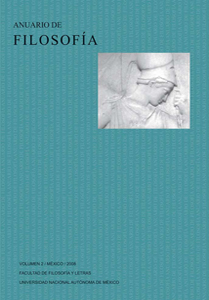De lo visible y lo invisible. La teoría de la visión en Berkeley vs. Descartes
Main Article Content
Abstract
In this paper, I follow in a critical manner some of the arguments of Berkeley taken from (An essay towards a New Theory of Vision, 1709), mostly centered against the Cartesian optic-geometry (La Dioptrique in Discours de la méthode and Essays, 1637); in particular all those referred to the visual perception in distance. This strategy of analysis will put in clear that these two philosophers, both made a research the visual phenomena from different perspectives, that is the reason why neither of these theories can be considered as non valid or replaced by another, at the contrary, we need to understand each theory and value his significance nowadays in their own context and his own terms. Descartes in his “Dioptrique” leads his research to the physical exploration of the light movement, also as the exposition of the physiological and anatomical of the mechanics of vision; meanwhile Berkeley by his way opens the new investigation of Psychology of vision, through this, he gave a new solution to understand the problem of the nature of the vision, within the frame of his inmaterialistic philosophy. This is the reason why Berkeley considered the need to denounce the fails of Descartes in his geometric optics. We will see how this denounce is according with the philosophical terms of Descartes or not.
Article Details
How to Cite
Velázquez, A. (2012). De lo visible y lo invisible. La teoría de la visión en Berkeley vs. Descartes. Anuario De Filosofía, 2. Retrieved from https://journals.unam.mx/index.php/afil/article/view/31555


